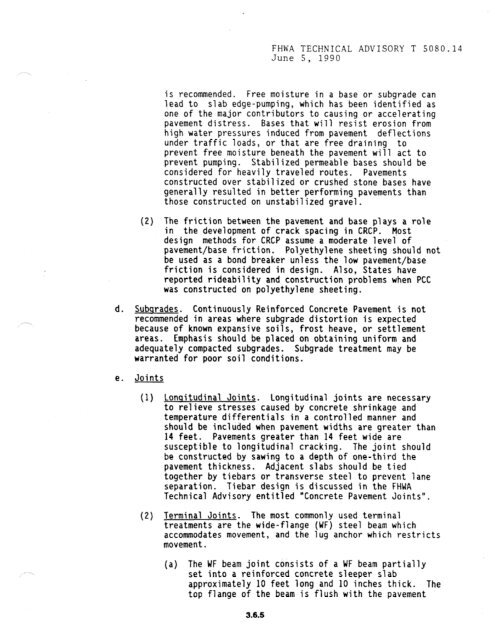chapter 3 rigid pavement - DOT On-Line Publications - Department ...
chapter 3 rigid pavement - DOT On-Line Publications - Department ...
chapter 3 rigid pavement - DOT On-Line Publications - Department ...
You also want an ePaper? Increase the reach of your titles
YUMPU automatically turns print PDFs into web optimized ePapers that Google loves.
FHWA TECHNICAL ADV ISORY T 5080.<br />
June 5, 1990<br />
is recommended. Free moisture in a base or subgrade can<br />
1,ead to slab edge-pumping, which has been identified as<br />
one of the major contributors to causing or accelerating<br />
<strong>pavement</strong> distress. Bases that will resist erosion from<br />
high water pressures induced from <strong>pavement</strong> deflections<br />
under traffic loads, or that are free draining to<br />
prevent free moisture beneath the <strong>pavement</strong> will act to<br />
prevent pumping. Stabilized permeable bases should be<br />
considered for heavily traveled routes. Pavements<br />
constructed over stabilized or crushed stone bases have<br />
generally resulted in better performing <strong>pavement</strong>s than<br />
those constructed on unstabilized gravel.<br />
The friction between the <strong>pavement</strong> and base plays a role<br />
in the development of crack spacing in CRCP. Most<br />
design methods for CRCP assume a moderate level of<br />
<strong>pavement</strong>/base friction. Polyethylene sheeting should not<br />
be used as a bond breaker unless the low <strong>pavement</strong>/base<br />
friction is considered in design. Also, States have<br />
reported rideability and construction problems when PCC<br />
was constructed on polyethylene sheeting.<br />
d. Subqrades. Continuously Reinforced Concrete Pavement is not<br />
recommended in areas where subgrade distortion is expected<br />
because of known expansive soils, frost heave, or settlement<br />
areas. Emphasis should be placed on obtaining uniform and<br />
adequately compacted subgrades. Subgrade treatment may be<br />
warranted for poor soil conditions.<br />
e. Joints<br />
(1) Lonqitudinal Joints. Longitudinal joints are necessary<br />
to relieve stresses caused by concrete shrinkage and<br />
temperature differentials in a controlled manner and<br />
should be included when <strong>pavement</strong> widths are greater than<br />
14 feet. Pavements greater than 14 feet wide are<br />
susceptible to longitudinal cracking. The joint should<br />
be constructed by sawing to a depth of one-third the<br />
<strong>pavement</strong> thickness. Adjacent slabs should be tied<br />
together by tiebars or transverse steel to prevent lane<br />
separation. Tiebar design is discussed in the FHWA<br />
Technical Advisory entitled "Concrete Pavement Joints".<br />
(2) Terminal Joints. The most commonly used terminal<br />
treatments are the wide-flange (WF) steel beam which<br />
accommodates movement, and the lug anchor which restricts<br />
movement.<br />
(a) The WF beam joint consists of a WF beam partially<br />
set into a reinforced concrete sleeper slab<br />
approximately 10 feet long and 10 inches thick. The<br />
top flange of the beam is flush with the <strong>pavement</strong><br />
3.6.6<br />
14
















